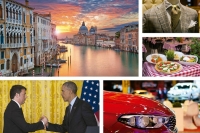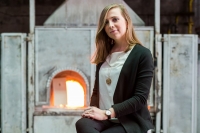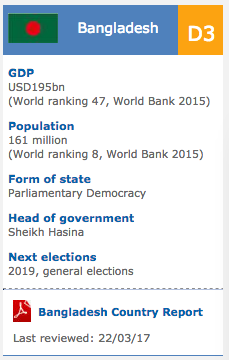Italy: I think Versace deserves to double its turnover
2013/07/21

Gian Giacomo Ferraris used to be a schoolteacher. And if you want to learn how to double your turnover in the next three years, than the Versace CEO is someone you could learn from. Lesson one: confidence. “I think Versace deserves to double its turnover. So for the next five years our target will be to become a one billion dollar company,” he says.
A tall order, but Ferraris’ track record since taking the reins in 2009 suggest he may just be the man to pull it off. Despite Versace taking up its usual slot on the red carpet back in 2009, the iconic fashion brand was struggling behind the scenes with critical implications to its bottom line due to the economic crisis and the lack of a fixed strategy.
However, due to its strong DNA, the company was able quickly react and started seeing a significant uptick in their revenues in 2010 and finally profitability in 2011. This allowed the brand to re-enter the haute couture fashion shows and capitalise on creative director Donatella Versace’s expertise.
Presently, Versace is looking to become a billion-dollar company in the next five years, which is double their current reported revenue of $528.4m in 2012. The man who is spearheading this vision is Ferraris. Prior to his role at Versace, Ferraris was CEO of the Jil Sander Group, and the managing director of the ready-to-wear division of Gucci Group, with responsibility over all the group’s brands, inclunding Gucci, YSL, Balenciaga, Stella McCartney, Alexander McQueen and Bottega Veneta.
“I joined in 2009, among the worldwide crisis,” says Ferraris. “For us, it was strategically fundamental to define a medium- and long-term strategy, which means we want to be very Versace. And thank God, just like the oil is in this country, we have this endless creative energy, who is Ms. Donatella Versace.”
The Middle East is a key player in this strategy, as Versace celebrates its new partnership with Samra International, a fine jewellery retailer, distributor and manufacturer, which is based in Dubai. This partnership gives Samra the right to produce Versace’s atelier jewellery for the world market.
“Originally, in 2009, Samra was our retailer and regional distributor. We noticed instantly that there is a good feeling between us as we spoke the same language in terms of our products culture,” Ferraris continues. “We started up an atelier with them in Dubai Mall. This is where we have our incomparable pieces which are very exclusive.
“In 2013, we signed a worldwide licence, so we trust in their capacity to translate the same energy that we have in the atelier and the total range of our product. We need to have a coherency in quality, in service, in craftsmanship and in everything else.”
The Middle East is an significant market for the iconic brand, and not just in terms of jewellery. Not only are the well-heeled locals in the Gulf large fans of Versace’s products, but the retailer can as well tap into the a lot of worldwide tourists who are increasingly using cities like Dubai as a stopping-off point.
“Culturally, we know that a large part of our turnover is related to the Gulf area,” says Ferraris. “Certainly additional than ten % and it will any minute at this time reach fifteen %.” This means the Middle East region is by presently the third-major source of revenue for the fashion- luxury lifestyle label, sitting just behind Europe and the Far East, and on a par with the US.
It’s therefore no amaze to see that Versace has put up its regional flagship, a physical free standing jewellery boutique, in Dubai Mall.
“In our flagship stores, we are putting the jewellery and exclusive pieces,” adds Ferraris. “Due to Samra holding the licence rights, we agreed that the initial initial start-up of our investment would be in the Gulf area. Again we roll out in Russia, China, and throughout.”
Versace celebrates its 20th anniversary of producing fine jewellery this year. According to Ferraris, Gianni Versace was the initial designer that entered into this kind of lifestyle culture.
“The genius of Gianni, who created the brand in 1978, started as a couturier,” he points out. “He was a tailor, working with his mother. Next his initial year of success, he did not just stop at the ready-to-wear business; he entered into the accessory business, and again created a whole company for watches, perfumes and home collection. So this was the genius of Gianni.”
Since the passing of Gianni, who was assassinated in 2009, Donatella Versace has been the guardian of the brand and its spirit.
“We need a voice that is able to coordinate the energy and give the distinction of the brand,” says Ferraris. “Donatella is our creative mind, so her involvement is total, which means that not a single piece exits to the customer without the physical approval of Donatella. It does not mean that she is continuously working. She has a team, but she has 100 % power to decide.”
One of Donatella Versace’s major strategies to pull Versace into the 21st century took place in 2010, at the same time as the firm took the opportunity to collaborate with H&M.
“This was a large opportunity for us to catch and inform the new generation and offer a luck for them to approach our product for the initial time,” says Ferraris. “This worldwide event was very successful and this was the key point to entering into a new customer generation.”
According to the CEO, the average Versace customer is a loyal customer, glamorous and up to date with fashion. They expect consistency and exceptional quality; however, they as well need to experience constant innovation.
“By giving them the reinterpretation of the iconic pieces, which is essentially our DNA, we could count on this loyal clientele. This way, there is always going to be space to grow, even in a crisis,” Ferraris says.
An extra increase strategy that the company is utilising is highlighted through their commitment to emphasise Versace as a luxury lifestyle brand. Palazzo Versace, a $626m hotel and resort based in Dubai, is presently being finalised and construction will continue apace for a 2014 target.
“Presently we are finalising Palazzo Versace here in Dubai for 2014. It is presently in full speed and will be located on the opposite side of Festival City,” says Ferraris.
The hotel has had something of a difficult start in life. Palazzo Versace Dubai was launched in 2006 by Emirates Sunland Group, a 50:50 joint venture between Enshaa’s subsidiary firm Emirates International Holdings (EIH) and Australian developer The Sunland Group. The design includes two Versace-branded residential buildings comprised of 169 units, and a Versace-designed hotel with 217 suites.
Sources say the project has encountered a series of delays since its launch due to different issues, inclunding problems with a nearby dhow ship yard and a complete project redesign. In March 2012, developer Enshaa Services Group said it would deliver the project by the end of 2013 and was even aiming for a soft opening this summer.
That aside, Versace is looking like it’s in pretty good shape. The firm has even been linked with an investment from Qatar Holding, although the Gulf sovereign wealth fund is remaining tight-lipped on the issue. Last year, it posted a 7.6 % rise in profits to $10.9m, as it continues to improve since reaching profitability in 2011.
However, while the brand may be large, the company is still not in the same league – profits-wise, at least – as some of its competitors. Paris-based Hermes International posted profits of just under $1bn last year, while Italian fashion home Giorgio Armani saw operating profits of $452m. The biggest luxury group of them all, Louis Vuitton Moet Hennessy (LVMH) announced $4.5bn worth of net gain in 2012, although that sum came from a variety of different brands.
So despite Versace’s improved balance sheet, there is still some way to go before the profits match the brand.
“I think we are finishing the initial phase which brought the company until presently $500m too low,” says Ferraris. “But presently I think Versace deserves to double its turnover. So for the next five years our target will be to become a one-billion-dollar company.
“Not only with our mature markets, but because presently we are re-entering Japan and Korea by ourselves. As well we are re-entering Turkey and Brazil. Versace is a worldwide historically recognised brand, and we will exploit this opportunity.”
Global luxury sales to taper off in 2013
Increase in sales of luxury goods is expected to relieve slightly this year, hit by subdued spending in Europe and slower increase in China, consultancy Bain & Co said in a study in May.
Bain sees luxury goods increase cooling worldwide to four to five % in 2013 from five % last year at constant exchange rates.
The consultancy, which conducted the study with Italian luxury trade body Altagamma, estimate world luxury goods sales would rise at a compound annual increase rate of five to six % between 2013 and 2015.
The total size of the market, which was 212bn euros ($273bn in 2012, would reach 250bn by mid-decade.
The study covers worldwide spending on luxury ready-to-wear, perfume and cosmetics, watches, jewelry, and accessories.
In the initial quarter of 2013, world luxury sales rose three % at constant exchange rates and one to two % at current exchange rates, against ten % in 2012.
Bain estimate luxury goods sales would remain sluggish in Europe this year, rising by a maximum of two %, compared with three % in 2012.
Chinese tourists were spending less in Europe due to narrowing price gaps with goods at home and were travelling to new destinations, it said, while local request in Europe remained depressed.
Bain estimate increase in the Asia-Pacific region, excluding mainland China, would reach seven to nine % this year, down from ten % last year. For mainland China, it estimate increase of six-eight %.
Bain predicted high consumer confidence in the United States combined with store openings would help drive increase there, while request in Brazil would remain strong. It as well saw a pick up in Japan, helped by its efforts to stimulate its economy.
- Related Articles

Climate change laws around the world
2017/05/14 There has been a 20-fold increase in the number of global climate change laws since 1997, according to the most comprehensive database of relevant policy and legislation. The database, produced by the Grantham Research Institute on Climate Change and the Environment and the Sabin Center on Climate Change Law, includes more than 1,200 relevant policies across 164 countries, which account for 95% of global greenhouse gas emissions.
Brexit negotiations should treat energy as ‘special case’
2017/05/14 There are strong practical reasons why the UK and EU should treat energy as a appropriate case during Brexit negotiations, argues a new statement. The statement, jointly authored by Chatham Home, the University of Exeter and the UK Energy Research Centre (UKERC), says finding common ground on energy during the Brexit negotiations would benefit both the UK and remaining EU27, while compromise may be relatively easier to achieve than for other areas.CDP catalyzes Italy’s long-term growth through investment and addressing market failures
2016/12/10 Italy’s Cassa Depositi e Prestiti (CDP), the national promotional bank with a €400 billion budget, is on a mission to jump-start the Italian economy. Essentially the country’s sovereign wealth fund, the CDP assists companies of all sizes—particularly corporations and companies involved in real estate and infrastructure—with venture capital funds and investing as a long-term partner. Chaired by former Goldman Sachs investment banker Claudio Costamagna, the CDP is currently developing a Turnaround Fund to help companies that are still solid but are facing financial issues by intervening in their control and relaunching them with new management.
Italy's 21st Century Reformation Back in the driving seat
2016/10/09 With renewed confidence, Italy is seeing the knock-on result of an ambitious reform schedule. The country is taking the lead to shape a new European vision and has emerged as a crucial diplomatic and geostrategic player in the Mediterranean region The eighth biggest economy, the fifth most popular tourism destination, and the undisputed world capital of the three F’s (fashion, furniture and food), the Italian treasury is buoyed by an exceptional luxury manufacturing sector, and the major number of UNESCO heritage sites on the planet. Hit hard by the Great Recession of 2008 which obliterated 6% of the country’s GDP, Italy is at last emerging from its longest economic crisis.
Giulia Chimento, Partner at Venini
2016/05/25 Elegant, hand-made glassware and chandeliers steeped in history and tradition from ‘the Dior of lighting and vases’ is very much the forte of the renowned high quality glassmaker Venini. Partner of the highly respected family-run company Giulia Chimento provides a fascinating insight to its heritage, craft and evolution, and what’s next for the creative artisans.
- Italy News
-
- AFGHANISTAN: UNWTO: International tourism – strongest half-year results since 2010
- ALBANIA: US LNG exports make European market more competitive
- ITALY: Italy Current Account Surplus Grows In June
- ITALY: Italy to send new ambassador to Egypt year after recalling ex-envoy
- ITALY: Italy seizes NGO rescue boat for allegedly aiding illegal migration
- FRANCE: France and Italy quarrel over shipyard and Libya
- Trending Articles
-
- SOUTH AFRICA: Nigeria and South Africa emerge from recession
- BAHRAIN: Bahrain issues new rules to encourage fintech growth
- UZBEKISTAN: Former deputy PM named Uzbekistan Airways head
- ARUBA: Director of Tourism Turks and Caicos after Irma: Tourism, visitors, hotels current status
- ANGOLA: Angola: Elections / 2017 - Provisional Data Point Out Qualified Majority for MPLA
- WORLD: How fair is our food? Big companies take reins on sourcing schemes












